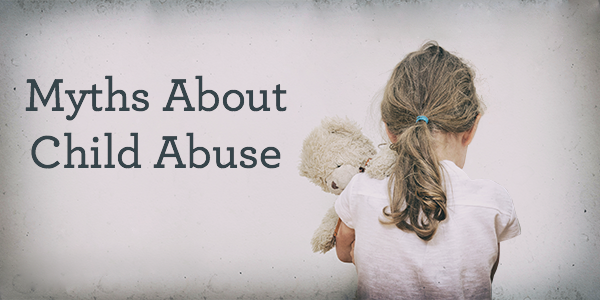Fact or Fiction – What is True About Child Abuse?

*Written by guest blogger Katie Bassett who handles public relations for Safer-America, a consumer advocacy group that provides public safety awareness information.
(This article is part of a series for National Child Abuse Prevention Month. Be sure to check out these related posts: “Child Abuse and Neglect: What You Need to Know” and “Recognizing the Signs of Child Abuse and Neglect”)
We have all formed our own ideas about child abuse based off the statistics we have been provided through the news and media. However, many of our assumptions are actually often myths, and there is a lot more in-depth information about this terrible epidemic. To raise awareness, we have identified some of the biggest misconceptions about child abuse along with their realities.
Myth #1: Child abuse only happens in lower economic classes of society.
Fact: Child abuse is all around us and doesn’t discriminate. It happens in big cities, small towns, in homes, schools and churches. It affects all races, socioeconomic classes and communities and can occur in many forms including physical abuse, emotional abuse, verbal abuse, mental abuse, sexual assault or neglect.
Myth #2: Strangers are often the perpetrators of child abuse.
Fact: According to the 2016 Child Maltreatment report, the majority (77.6%) of perpetrators of child abuse and neglect are the child’s own parents. 6.2% of victims were maltreated by a relative other than a parent.
Myth #3: The most common form of abuse children experience is sexual abuse.
Fact: The greatest percentages of children suffered from neglect (74.8%), meaning their caregivers failed to meet their basic needs including adequate health care, supervision, clothing, nutrition, housing as well as their physical, emotional, social, educational and safety needs. 18.2% of children were physically abused.
Myth #4: All abuse takes place by men, especially fathers.
Fact: While men are offenders in several cases, that doesn’t mean women aren’t also capable of abusing innocent children. Females are often overlooked as offenders; however, it has been suggested that women may have an easier time abusing children by taking advantage of their traditional caretaker role within a family. The 2016 Child Maltreatment report found that more than half of perpetrators responsible for the abuse or neglect of a child were women.
Myth #5: It is easy to identify a victim of child abuse or neglect.
Fact: Our society is taught to look for common signs of child abuse and neglect such as unexplained injuries, irrational fears, sudden changes in behavior and more. However, not all victims exhibit obvious signs of abuse. Even if children know they are experiencing a dangerous situation, they may be too afraid or ashamed to speak up. It is important that children are taught to recognize if they are being abused and feel safe reporting it.
Myth #6: Removing the child from abusive adults will solve the problem.
Fact: Ensuring a child’s safety is the highest priority; therefore, removing them from a dangerous situation is critical. However, the simple removal of a child doesn’t fix the issue. Traumatic childhood experiences such as abuse impact how a child views him or herself and responds to the world. Trauma impacts important regions of the brain responsible for problem-solving, emotion regulation and memory. Additionally, it is hard to describe a child’s bond with his or her parents or their abuser, regardless of their abusive habits, which can make the removal process even more difficult. It is important for children to get the necessary support they need from caring professionals and caregivers such as foster families immediately after a traumatic event. This can help them better cope with the situation and return into a safe environment. Left untreated, children who have experienced trauma can develop life-long problems including the inability to regulate emotions, behavioral problems, difficulty learning, mood disorders and health issues.
If you suspect a child is being abused or neglected, call 1-800-4-A-CHILD.
Everyone has a role to play in preventing child abuse. Please join KVC as a foster or adoptive parent, mentor, volunteer, donor or advocate for children and families. Learn more about our work and get involved in Kansas, Missouri, Kentucky, Nebraska and West Virginia.
Related articles:




